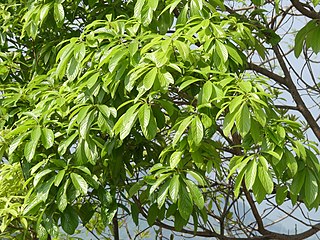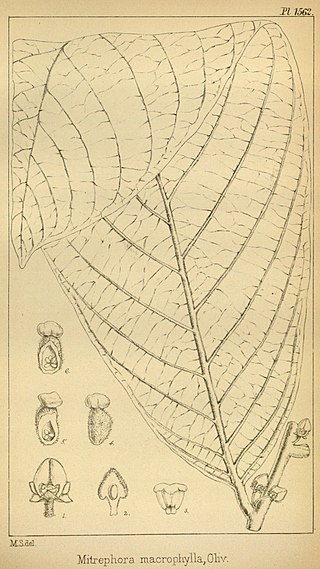
George Bentham was an English botanist, described by the weed botanist Duane Isely as "the premier systematic botanist of the nineteenth century". Born into a distinguished family, he initially studied law, but had a fascination with botany from an early age, which he soon pursued, becoming president of the Linnaean Society in 1861, and a fellow of the Royal Society in 1862. He was the author of a number of important botanical works, particularly flora. He is best known for his taxonomic classification of plants in collaboration with Joseph Dalton Hooker, his Genera Plantarum (1862–1883). He died in London in 1884.

Robert Wight MD FRS FLS was a Scottish surgeon in the East India Company, whose professional career was spent entirely in southern India, where his greatest achievements were in botany – as an economic botanist and leading taxonomist in south India. He contributed to the introduction of American cotton. As a taxonomist he described 110 new genera and 1267 new species of flowering plants. He employed Indian botanical artists to illustrate many plants collected by himself and Indian collectors he trained. Some of these illustrations were published by William Hooker in Britain, but from 1838 he published a series of illustrated works in Madras including the uncoloured, six-volume Icones Plantarum Indiae Orientalis (1838–53) and two hand-coloured, two-volume works, the Illustrations of Indian Botany (1838–50) and Spicilegium Neilgherrense (1845–51). By the time he retired from India in 1853 he had published 2464 illustrations of Indian plants. The standard author abbreviation Wight is used to indicate this person as the author when citing a botanical name.

Icones Plantarum is an extensive series of published volumes of botanical illustration, initiated by Sir William Jackson Hooker. The Latin name of the work means "Illustrations of Plants". The illustrations are drawn from herbarium specimens of Hooker's herbarium, and subsequently the herbarium of Kew Gardens. Hooker was the author of the first ten volumes, produced 1837–1854. His son, Sir Joseph Dalton Hooker, was responsible for Volumes XI-XIX. Daniel Oliver was the editor of Volumes XX-XXIV. His successor was William Turner Thiselton-Dyer. The series now comprises forty volumes.
Cleistachne is a genus of African and Asian plants in the grass family. The only known species is Cleistachne sorghoides, native to Eastern Africa and Southeastern Africa, and parts of Asia.
Lophacme is a genus of African plants in the grass family.
Lepidostephium is a genus of South African flowering plants in the family Asteraceae.
Oxylaena is a genus of flowering plants in the pussy's-toes tribe within the sunflower family.
Azorella filamentosa is a species of flowering plant in the genus Azorella existing in Chile and the Falkland Islands.
Uranthoecium is a genus of plants in the grass family. The only known species is Uranthoecium truncatum, native to Queensland, New South Wales, South Australia, Northern Territory, and Western Australia. A common name is flat-stem grass.
Chiliocephalum is a genus of Ethiopian flowering plants in the family Asteraceae.

Persoonia laurina, commonly known as the laurel-leaved or laurel geebung, is a shrub of the family Proteaceae native to central New South Wales in eastern Australia. Found in sclerophyll forest, it grows to a height of 2 metres. The yellow flowers appear in late spring.
Aulacocalyx is a genus of flowering plants in the family Rubiaceae. It is found in tropical Africa.

Petraeovitex is a genus of eight climbing shrubs species known to science, of the mint family Lamiaceae . Collectively, they grow naturally in Borneo, Peninsular Malaysia, Sumatra, the Philippines, the Moluccas, New Guinea, Bismarck Archipelago, the Solomon Islands and Cape York Peninsula, Australia.

Mahonia gracilipes is a shrub in the family Berberidaceae, first described in 1887. It is endemic to China, native to the Sichuan and Yunnan Provinces.

Buxus macowanii, aka Cape box, is an evergreen species of boxwood endemic to South Africa, where it occurs in two disjunct populations - in coastal forest and shady ravines from the Eastern Cape to southern Natal, and in the Waterberg of the central Transvaal. The genus Buxus, comprising more than 100 species, is found worldwide, but is absent from Australia.

Eucalyptus nutans, commonly known as red-flowered moort, is a species of mallet that is endemic to a small area near the south coast of Western Australia. It has smooth bark, oblong to almost round adult leaves, flower buds in groups of seven, red or pinkish flowers and cup-shaped to conical fruit.

Phoebe hainesiana is a species of tree in the family Lauraceae, native to India. It is the state tree of Manipur.

Pseuduvaria macrophylla is a species of plant in the family Annonaceae. It is native to Peninsular Malaysia, Sumatra and Thailand. Daniel Oliver, the English botanists who first formally described the species using the synonym Mitrephora macrophylla, named it after its large leaves.

Triglochin calcitrapa is a species of flowering plant in the family Juncaginaceae, first described by William Jackson Hooker in 1848, and native to south-west Western Australia.










